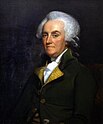Wikipedia:Today's featured list/October 14, 2013
New Jersey was overseen by a succession of colonial governors in the 150 years prior to the American Revolution. James, Duke of York, divided New Jersey between George Carteret and John Berkeley, 1st Baron Berkeley of Stratton, in 1664, to reward their support of the monarchy during the English Civil War and Interregnum. They sold their interests to two groups of proprietors who divided these holdings into two colonies—East Jersey and West Jersey. Remaining in England, these proprietors tended to administer the colony through deputies until the 1690s. The proprietors for East and West Jersey surrendered their political authority to the British Crown in 1702, and New Jersey was then unified as a crown colony under an appointed governor. At first, the colony shared its governor with the neighboring Province of New York (1702–38), and then had its own (1738–76). As tensions between colonists and the King rose to rebellion, the last royal governor, William Franklin (pictured), was deposed and arrested in June 1776 by order of the colony’s transitional government. (Full list...)

